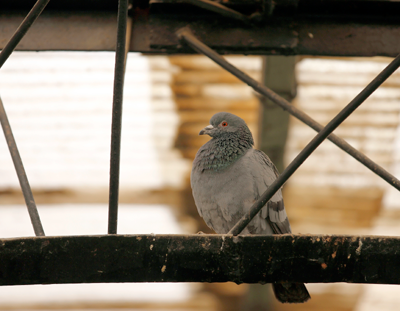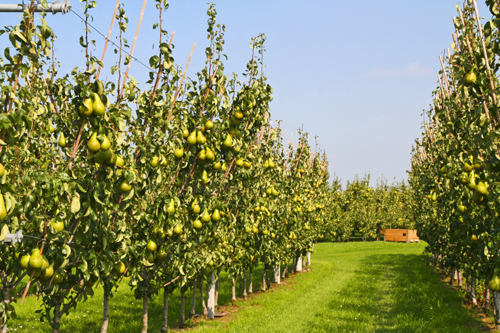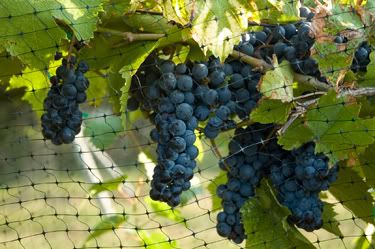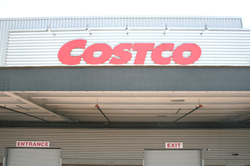
As a homeowner, you know the problems pest birds can create when they’re allowed to roost and nest in eaves, canopies, awnings and other covered areas around your home. The beams of your patio cover, gazebo and other elevated backyard structures offer an ideal sanctuary for birds. These areas protect them from weather and predators. Unfortunately, when birds gather there, they create quite a mess down below—on your patio table, chairs, BBQ, walkways, spa, pool and thru-window serving bars. Kids toys can also become covered with disease carrying bird droppings.
Fortunately, there are a number of effective and humane bird control products you can use to keep birds away from your eaves, canopies and awnings:
Garden Bird Netting
A lightweight, easy to handle mesh, Garden Bird Netting physically denies pest birds access to specific areas of your home. It comes in 14 x 100-foot and 14 x 200-foot rolls and can easily be cut down to the size you need. It’s also available in three different "mesh" sizes: 1/4", 1/2" and 3/4" mesh. The netting installs easily under eaves and other areas, and bird netting clips are available to further speed installation. The best garden bird netting is made from a durable, UV-protected polypropylene. It’s strong, lightweight, designed for temporary use and practically invisible.
Bird Slope
Another bird control product that effectively denies birds access to your eaves is Bird Slope. The angled PVC panels won’t allow birds to gain a solid footing on its slippery surface. After a few tries of “squirrel-caging” on the panel, birds just give up and move on. Bird slope panels come in different colors to blend in with your home’s exterior. The panels are easy to install using glue, nails or screws and they're basically maintenance free.
Copper Stuf-Fit Mesh
If your home has a number of small holes and crevices under the eaves and other architecture, Copper Stuf-Fit mesh will keep birds out. It works great for all those tight spaces too small for regular netting or other bird control products. The mesh comes in 20-foot and 100-foot roles and can be “shaped” to conform to the area needed to keep birds out. Stuf-Fit mesh holds its shape in small, narrow areas so birds can’t “work” their way around it. The mesh can even keep birds from getting under your roofing tiles, retractable awnings, and junctions where pipes enter your siding or foundation.
No Nasty Nest
Simple but effective, No Nasty Nest uses hanging "twine" to block birds from potential nesting sites. Confronted with working through a gauntlet of twine strips, birds will simply move on to a better nesting spot. If you had swallow mud nests under the eaves and sides of your home last year, No Nasty Nest makes a great bird deterrent. Each strip of No Nasty Nest features a self-adhering back for quick application on eaves, gables, entryways and other areas.

by Alex Kecskes
If your home has a separate garage or shed, you probably have pest birds roosting and nesting either inside or under the eaves. Birds love to perch on the rooftops and exposed beams of these structures. And unless you deter them with some bird control device, birds will continue to gather in greater numbers in and around these structures. Eventually, birds will even start to nest and roost under the eaves of your home.
The longer you wait to implement some effective bird control measures, the more brazen the birds will become. They’ll start to gather in your back yard and leave droppings all over your pool, spa, patio, and BBQ. Keep in mind that birds can carry any of 60 known diseases. If you have children or pets, you’ll be cleaning up the bird droppings on a daily basis.
The good news is that there are a number of humane and effective bird deterrents that you can use. Here are a few that you should look into:
Garden Bird Netting
Lightweight and easy to handle, Garden Mesh Netting will block birds from specific nesting sites around your shed or garage. It comes in 14 x 100-foot and 14 x 200-foot rolls, but you can easily cut it down to the size. It’s also available in three different "mesh" sizes--1/4" mesh, 1/2" mesh and 3/4" mesh. It’s easy to install under eaves and other areas, especially if you use the bird netting clips that are recommended. The netting is made from a durable, UV-protected polypropylene. It’s strong, lightweight and virtually invisible.
Bird Slope
Scientifically designed to keep pest birds away from eaves and similar nooks and crannies, Bird Slope are slippery PVC panels that mount under eaves to prevent birds from gaining a foothold. They scramble and “squirrel-cage” with their little toes and finally give up, moving on to other more hospitable areas. The best bird slope panels are UV protected and sun- and weather-resistant to last longer. Bird slope is ideal for deterring a wide range of birds—including swallows, starlings, pigeons and seagulls. The panels blend in with most architectural styles and they’re now available in two colors--stone and grey.
Copper Stuf-Fit Mesh
Ideal for keeping pest birds out of small holes and crevices, Copper Stuf-Fit mesh creates a physical barrier that blocks out birds. It’s ideal for use in openings and tight spaces too small for regular netting or other products. The mesh comes in 20-foot and 100-foot roles and can be “formed” into the shape of the area needed to deny birds access. The wire mesh will hold its shape in tight areas to prevent birds from “working” their way around it. It can also be used to block birds from getting under roofing tiles, retractable awnings, and where pipes enter siding or foundations.
No Nasty Nest
Ideal for use in blocking swallows, No Nasty Nest consists of hanging "twine" that denies birds access to nesting sites. Faced with wading through the twine strips, birds will simply move on to a better spot to nest. If you have swallow mud nests under the eaves and sides of your garage, shed or home, you’ll want to get this bird deterrent. Each strip of No Nasty Nest has a self-adhering back for fast application on eaves, gables, entryways and other areas.

by Alex A. Kecskes
A beautiful garden can be a joy to behold. It reflects the hours of work and care you put into it—the feeding and weeding and spraying for bugs. But unless you exercise some form of effective bird control, your well-tended garden can quickly be ruined by pest birds. Vegetable and fruit gardens are particularly vulnerable. While a few songbirds can add a certain ambiance to a garden, gathering flocks of birds—like crows, pigeons, finches—can destroy ripening fruit and vegetables. They can leave droppings everywhere, turning your garden into a smelly, disease-carrying mess.
The only way to protect your garden is with proven effective bird deterrents. And the best way to ensure your garden won’t be attacked by flocks of pest birds is to implement these bird deterrents before your fruits and vegetables ripen.
Here are three of today’s most popular and effective pest bird deterrents:
Plastic Bird Netting
Creating a physical barrier that denies birds access to specific areas of your garden, Plastic Bird Netting offers a humane, low profile bird deterrent. The netting usually comes in 14 x 100-foot and 14 x 200-foot rolls and three different mesh sizes. There’s a 1/4-inch mesh for smaller birds and a 1/2-inch mesh and a 3/4-inch mesh for larger birds. The best plastic bird netting is fabricated from durable, U.V.-protected polypropylene. This netting is strong, light, easy to handle and virtually invisible.
Install bird netting before your garden bears fruit or vegetables. Suspend the netting over your bushes or vines by at least 6 inches. Protect vegetables by wrapping individual plants in netting or suspend the netting around an entire garden area. To safeguard fruit trees, measure the circumference of the tree and cut the net to size (allow at least one foot extra around the circumference). Secure the netting with twine, zip ties, or hog rings.
Sonic Bird Deterrents
These devices broadcast bird distress and predator calls that make birds feel too uneasy to stay in your garden. The sounds resemble normal bird sounds, so they won’t irritate your pets, friends or neighbors. One highly versatile sonic system can emit distress and predator calls for 22 different species of birds. This unit covers up to an acre of land and can be programmed to turn on or off at night.
Visual Bird Deterrents
Ideally, you would want to use Visual Bird Deterrents in conjunction with the two deterrents mentioned above. These consist of Flash Tape and Reflective Banners, which reflect sunlight and snap in the breeze to make birds too nervous to feed. Also included in this category are Scare Eye Diverters and Bird Scare Balloons—both feature large predator eyes to intimidate pest birds. Visual bird deterrents attach easily to patio covers, gazebos, tree branches, or any elevated area in your garden. Just remember to move them around frequently to convince birds they are “live” threats.

by Alex A. Kecskes
As a homeowner, you know that pest birds can cause considerable damage to your garden. Fruits are especially vulnerable and can be quickly ruined by even a few birds.
Today, 95 percent of all American gardens grow tomatoes. One woman in North Texas suffered extensive damage to her tomato plants by mockingbirds. As soon as her tomatoes got red, ripe and ready to pick, the birds would take bites out of them. They would continue to nibble on her tomatoes all day long. A great-looking tomato, almost ready to pick in the morning, would be ruined with bite marks by late afternoon. Effective pest bird deterrents would have saved her tomatoes.
A sure sign that birds are attacking your fruit is the presence of holes throughout. Starlings and blackbirds can eat the fruits and vegetables you worked so hard to grow. Canada geese will munch on your grass and leave nearly a pound a day (per goose) of droppings. Birds can also damage your favorite trees. They’ll rip through bark searching for bugs. Few plants are safe from pest birds. They’ll use their beaks to rip, tear and tug your plants pieces.
The temptation is to resort to lethal bird control measures—like BB guns and poisons (avicides). But if you have pets or children, these methods are highly undesirable as well as being inhumane to birds. Fortunately, there are a number of bird deterrents on the market that are both effective and humane. They’re ideal for keeping pest birds out of your garden. Here are three proven bird control measures:
Lightweight Plastic Bird Netting
Plastic bird netting lets you exclude pest birds from garden, enclosed courtyard, patio or similar area. The netting comes in various mesh sizes to block out pigeons, sparrows, starlings, seagulls and other birds. The best high quality bird netting is available in various colors to blend in with your garden’s décor. One manufacturer offers a bird netting kit for fast, easy installation. The kits include perimeter cable, cable crimps, turnbuckles, intermediate attachments, hog rings, and accessories and tools.
Sonic Deterrents
These devices generate distress and predator calls that make birds too scared to hang around and feed. One commercially available system can generate such calls for 22 different species of birds. The calls, repeated every 10 minutes, resemble natural birdcalls to humans and won’t irritate pets. You can set a volume control to generate from 65-105 decibels, and you can program the unit to turn on or off at night. The best bird sonic units come with a built-in speaker that protects gardens up to an acre.
Bird Scare Deterrents
These inexpensive bird deterrents create an “Optical Distraction Zone” that makes pest birds too nervous to hang around your garden. They consist of reflective foils, shiny tape banners and balloons that are easy to install. Some balloons have giant predator eyes to give birds that “spied on” feeling. Balloons can also be filled partially with water to skim the surface of swimming pools, spas and Koi ponds.

By Alex A. Kecskes
You just got a new sailboat for the summer. And you plan on taking it out with friends and family, maybe even the boss. The boat’s all shiny and new. The sails are spotless. Every inch of your new boat says: I care about this vessel. But then you look at the boats on either side of your dock. They’ve been around for awhile. And they’ve endured the ravages of pest birds—the seagull nests, feathers and droppings, the dead fish scraps. You ask yourself: Will my boat be next?
If your boat’s moored in the Cape Cod area, you can expect an invasion of cormorants from the end of August till sometime in October. These annoying birds will sit on any thin, horizontal wires or structures. They don't sit on decks but on your spreaders and create a huge, smelly mess. The mix of fish fat and calcium from fish bones is worse than any glue. The only way to get it off is to sand it off.
If your boat’s moored on the other coast--in San Diego--you can expect major problems with Sea Gulls, Pelicans and Blue Herons landing on your fore deck, dodger and bimini. You may also have occasional problems with Pelicans landing on the masthead.
The solution is to implement an effective bird proofing strategy for your boat. Do this and while you may have an occasional dropping from a fly-over, pest birds will no longer just sit and poop on your boat. Here are a few simple time-honored pest bird deterrents that you can use to keep your boat clean and sanitary:
Bird Netting. Often sold to growers to protect trees and plants, lightweight bird netting can be highly effective in excluding pest birds from your boat. The netting is typically black and hard to see from a distance. Some sailors drape a section of netting over the boom and clip it to the side rails with clothespins. You can cut off a section for the fore deck and attach at several key points—leaving just a bit of slack. You’ll find that most birds simply won't land on the unstable netting. Best of all, netting is easy to put and take down in minutes. Good bird netting will last you for several seasons.
Bird Spiders. Gulls, especially, hate these devices because the flagellating stainless steel “arms” whip around in the breeze and that makes them extremely nervous. Spiders are available in 2-, 4- and 8-foot diameter arm lengths to offer ever-expanding areas of protection. They are easy to install and have no moving parts to wear out. Choose bird spiders that have a U.V.-protected polycarbonate base—they will last longer. One manufacturer offers a bird spider that comes pre-assembled. Some spiders come with a glue-on base, so they can be glued down permanently to most flat surfaces. You can also get railing mounts for easy attachment to boat rails. Other attachments include a bag base that gives you the freedom to place the spider practically anywhere, including on your canvas covers and biminis.
Visual Bird Deterrents. These include reflective foil banners and strips as well as blow-up balloons. The strips and banners tend to crackle in the breeze and sparkle in the sunlight, which makes pest birds think twice about landing on your boat. Balloons covered with large predator eyes are no less intimidating. These devices are inexpensive and simple to install. One tip: string banners every few feet from your fore and aft halyards.
Solar Bird Repeller. This is for all you boat owners who like hi-tech gadgets. Yet unlike many high tech gadgets, this one really works to sweep pest birds off your boat. Best of all, it does the job on solar power! The continuously rotating 5-foot diameter arms keep even the largest pest birds at bay—including gulls, pigeons, and crows, cormorants and vultures. The two adjustable “arms” turn continuously at 30 RPMs. Solar Bird Repellers can be placed wherever they're needed to deter pest birds. They can even store the sun's energy to keep turning all night.

by Alex A. Kecskes
You take great pride in the appearance of your home. You paint it, replace or repair the siding, and maintain the shutters. After all that work and expense, you don’t need woodpeckers defacing your home with holes and unsightly marks. But it can happen--if you don’t implement effective woodpecker deterrents.
As many homeowners have painfully learned, woodpeckers can drill holes into wood siding, window frames, eaves, trim and fascia boards. They often hammer cedar and redwood siding until it looks like the surface of the moon. If you have a façade or decorative fir, pine or cypress, they’ll attack that too. Regrettably, woodpeckers prefer new construction and rustic, channeled plywood with cedar or redwood veneers. Many a homeowner has been saddened to discover the tell-tale narrow horizontal line of holes on the side of their home as woodpeckers forage for insects. These birds will even go after the plastic parts in your rooftop solar panels. Without effective woodpecker controls, your home is at the mercy of these pests.
As if damage to your home wasn’t enough, woodpeckers can drive you crazy with their incessant drumming--especially in the springtime. They seem to love to bang away at the hollow areas where their drumming makes the most noise. That includes your metal rain gutters, downspouts, chimney caps, TV dish antennas, rooftop plumbing vents, and metal roof valleys. Ask any homeowner with a woodpecker problem: these birds will drum all day long, week after maddening week.
It’s enough to make you want to whip out the BB gun or even bird poisons. Unfortunately for you and fortunately for them, woodpeckers are migratory, non-game birds that are fully protected by the Federal Migratory Bird Treaty Act. In fact, the red-cockaded woodpecker (Picoides borealis) and the ivory-billed woodpecker (Campephilus principalis) are both listed as Endangered Species and cannot be touched without incurring the penalty of law.
Fortunately for you, there are a number of effective and humane woodpecker control measures you can use to solve most woodpecker problems.
One widely used woodpecker deterrent is lightweight plastic bird netting. This method works because you’re physically excluding pest birds from specific areas. Birds simply can’t get at your property. Plastic bird netting typically comes in several mesh sizes to block out various size birds. For most woodpeckers, you’ll need a 3/4-inch mesh size. If you’re concerned about the appearance of bird netting, high quality netting is now available in various colors to match your home's exterior.
When installing the netting, be sure to leave a 3-inch space between the netting and the area to be protected. You don’t want the birds to drum their beaks through the mesh. You can also install bird netting to the overhanging eaves, then swing back to your exposed siding. For best results, secure the netting tightly to prevent birds from getting behind it.
To streamline the installation of bird netting, one manufacturer offers a bird netting kit. These kits include bird net hardware to help match any job. Things like perimeter cable, which can be set up around the area to be netted off to ensure that there are no gaps for birds to enter, and that the netting stays taut. The kits may also include netting hardware--items like cable crimps, turnbuckles, intermediate attachments, hog rings, and accessories and tools to ensure a correct and lasting installation.
It’s sometimes best to add additional deterrents to your home (in addition to netting). Combined, two woodpecker control approaches create an effective solution to the woodpecker problem. For example, consider installing some visual deterrents like banners that crinkle in the breeze and reflect sunlight. Or balloons emblazoned with large predator eyes to intimidate pest birds. For best effect, visual woodpecker deterrents should be moved around often so birds don't get used to them.
Above all, it’s important to be proactive and install these woodpecker controls and deterrents before the birds arrive. Once these birds have “set up shop,” it’s pretty hard to get rid of them.

by Alex A. Kecskes
Pigeons, sparrows, crows, gulls—they can become costly headaches to commercial warehouses. For starters, they create a dangerous distraction to employees operating forklifts and other machinery. And lest we not forget that bird nests, feathers and other debris are ideal kindling for starting fires near electrical equipment, wiring and hot lights.
Then there are the bird droppings, which create a whole slew of problems in warehouses. Not the least of which are slip-and-fall hazards. There’s also the contamination factor--birds can carry any of 60 known diseases. And the cost of damage to products on shelves and in loading docks can be severe. Finally, the acid in bird droppings can eat into packaging, obscure labeling codes and other shipping information. This can create all sorts of problems for inventory control and expediting personnel.
Rather than resorting to poisons or BB guns to clear your warehouse of pest birds, you should consider using non-lethal, humane bird deterrents.
One of the most effective bird deterrent systems on the market is the Automated Avian Fogging System. This advanced hazing system releases a fine fog into the air to deter pest birds from large spaces. It’s been proven highly effective in driving out pigeons, sparrows, crows, gulls, even vultures from warehouses, factories, airline hangers and many outdoor areas.
This powerful bird control tool is the first fogging unit to offer programmable components and a computerized touch screen. It works by dispensing a chemical known as methyl anthranilate--a grape extract proven to be effective in repelling pest birds. The extract irritates birds’ trigeminal nerve and mucous membranes through entry in the eyes, nose or mouth. Birds find the sensation very annoying and will seek the nearest exit the minute they get a healthy whiff of the chemical.
There’s plenty of flexibility in how the system dispenses the fogging chemical. For example, a control unit lets you attach up to 64 fogging “drop” units, and each unit can be controlled individually. An adjustable nozzle system lets you direct the chemical spray to areas where pest birds tend to flock and roost. A unique nozzle design delivers a 5-micron particle size spray, which leaves no chemical residue. What’s more, each drop station covers approximately 6,000 to 8,000 square feet. You can also control the dispensing times, so that the spray units will begin dispensing fog all at once or at alternating intervals. A convenient control panel monitors liquid levels, and notifies you when to refills are necessary.
Another effective pest bird deterrent for use in warehouses is No-Knot Bird netting. This low-profile netting creates a barrier that physically excludes pigeons, sparrows, gulls, starlings and crows. The netting is available in two mesh sizes to deter various size pest birds. For example, there’s a 2-inch mesh for pigeons and crows and 3/4-inch mesh for sparrows and smaller birds. No-Knot Bird Netting comes with a 10-year guarantee. It's fabricated of flame resistant, multi-strand polypropylene fiber and is highly resistant to many chemicals. It’s also ISO 1806 Protocol Mesh tested, and it won't rot, absorb water, or mildew. Another advantage of No-Knot Netting is that it is very light and easy to handle, yet it has a break strength of 50 pounds.
Before using any bird deterrents, be sure to remove bird droppings, feathers and nesting materials. (Birds are attracted to this debris and will regard the venue as “friendly.”) Use commercial disinfecting cleaning agents to prevent exposure to any of the 60 known airborne diseases caused by birds. You should also use eye and respiratory protection if the area is heavily contaminated with bird droppings.

by Alex A. Kecskes
Almost everyone has heard about pigeons invading parks and monuments, shedding their disease-carrying droppings on statues and contaminating ponds and playgrounds. But pigeons also pose a problem to many businesses. And perhaps the least mentioned are the many problems pest pigeons pose to gas stations.
Take your basic gas station canopy, for example. Once pigeons have claimed them and decided to nest on them, it's just a matter of time before a flock of pigeons can ruin your average $25,000.00 canopy.
Why do so many pigeons like to nest on gas canopies? Simple. They provide a great observation point for pigeons. The resourceful birds like to sit along the canopy edges and survey the area. And if you've ever seen how these canopies are built, you know that they easily provide plenty of protected nesting sites on their undersides and gutter areas.
Unless you get rid of pigeons, the flat metal roof areas will soon be covered with pigeon droppings and nests. Both will clog the canopy's drains and eat away at the canopy's paint and metal. After a rain, one can't help but notice the brown residue and offensive odor caused by collected pigeon droppings and nesting debris. This debris and unsavory odor will collect on the covered paved areas of a gas station and create and unwelcome site for customers. Worse yet, left to gather in the wet, pigeon droppings can cause dangerous slip-and-fall hazards to customers and employees. After several years, gas canopies can even become structurally degraded to cause a possible hazard for motorists and workers.
So what to do? If high gas prices aren't enough to keep motorists away, do you really need pest pigeons? Fortunately, there are several humane and highly effective ways to get rid of pigeons.
Intimidating Bird Spikes
The mother of pest bird deterrents, the Bird Spike has saved more buildings and structures from pigeons than perhaps any other deterrent. Bird Spikes get rid of pigeons because they simply can't negotiate a landing around them. The spiked strips come in rigid U.V.-resistant unbreakable polycarbonate, or longer-lasting, slightly more expensive stainless steel, which you can get in a non-reflective metal finish. These days you can even get bird spikes in a full spectrum of colors--including white, tan, gray, black, brown, brick red and crystal clear. The spikes are easily glued or screwed to any surface. Choose the Girder Spike for keeping pigeons off girders or I-beams (they come with adjustable “C-clamps” to fit any size girder). To keep pigeons off rain gutters, there's the Gutter Spike. The best bird spikes are blunted, safe for birds and maintenance crews and GSA approved.
Virtually Invisible Bird Slopes
Install these in the 90-degree nooks and crannies of your gas station canopy and pest pigeons will never be able to land. Bird Slopes are angled, slippery PVC panels that pigeons can't seem to get a grip on. The panels come in a variety of colors to blend in with your gas station's aesthetics. U.V.-stabilized polycarbonate panels are best as they stand up to years of inclement weather.
Wobbly Bird Wire Systems
This is a great way to get rid of pigeons. They'll wobble and shimmy off these Bird Wire Systems like Bozo on a banana peel. Pigeons, like most birds, prefer stable landing areas. And bird wire systems with their post-and-spring-wire set-ups are anything but stable. String these systems on the roofs of canopies or their undersides and forget about pigeons. The systems are easily installed, and even used on Federal and State government buildings. The best systems feature nylon coated stainless steel wire for lasting durability.
Barrier Pigeon Netting
Exclusion is the name of the game. And Bird Netting keeps them out of the corners and recesses of your gas station canopies like few bird deterrents can. It gets rid of pigeons by denying them access to these areas. The best netting is made from ISO 1806 mesh test polyethylene fabric. If you want the netting to last, get U.V.-stabilized, flame-resistant and rot and waterproof netting. Non-conductive netting is available for installations where electrical conductivity or radio frequency interference could cause problems--probably a good idea in gas stations. You can even get netting in several different colors--like including white, stone and black.
Stick it to 'em with Bird Gels
Like most birds, pigeons can't stand walking on these sticky gels. They get that stuck-in-flypaper feeling and can't wait to leave. Bird Gels are easy to apply using a standard caulking gun. The chemical skins over and stays sticky for up to six months.
 by Fran Prisco When pest birds are occupying your building, how do you keep them away? Installing humane bird guards is the answer. Birds like sparrows, starlings and pigeons are often found landing, roosting and nesting on or near office buildings in any large city. These birds are known as pest birds because of the damage and health risks they impose. Not only do their nesting activities cause damage to buildings, so do their droppings. Bird droppings are acidic and can quickly erode building materials costing building owners thousands to repair. The droppings left behind by birds can also be a health hazard; carrying any of 60 plus communicable diseases. Bird roosts can also harbor parasites and flees that can easily invade buildings. Cleaning Up Bird DroppingsIt is important that safety precautions are taken when cleaning up bird droppings and debris. - During the cleanup, seal heating and cooling air ducts or shut the system down. Only authorized cleanup personnel should be present.
- Healthy individuals should do the cleanup.
- Wear a respirator that can filter particles as small as 0.3 microns.
- Wear disposable protective gloves, hat, coveralls and shoe coverings.
- Moisten the droppings with a light mist of water to keep spores from becoming airborne and keep them wet.
- Put droppings into sealed plastic garbage bags.
- When finished and while still wearing the respirator, remove protective clothing and place it in a plastic bag.
- Wash or shower.
- Check with local government agencies to verify that disposal of the waste is permissible through standard trash pickup.
 If you run a grocery store, you know about health inspectors and health codes. You also know that the last thing you need in this fragile economy is a health code violation. Most cities in the U.S. have two types of violations: critical and non-critical. Pest birds can cause a critical violation. If you want to continue to do business, you must find a way to get rid of birds that may be loitering around your store. According to the U.S. Department of Agriculture, critical violations could cause a food-borne illness to infect a person. Most government inspection programs are based primarily on food safety, instead of food quality. Stores are categorized based on the food safety risk posed by any activity conducted in the store. If a store is handling easily spoiled or food subject to infection, such as raw meat or deli service, it is considered a high-risk store and inspections are conducted more frequently. Moderate risk stores include convenience stores that heat cooked foods like hot dogs or pizza. Low risk stores usually carry only pre-packaged, non-potentially hazardous foods. There are many ways to get rid of birds, which when spotted by health inspectors, may cause you to incur a health code violation.
|










 RSS Feed
RSS Feed